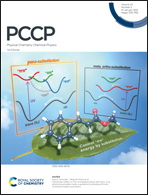Role of Mg2+ and In3+ substitution on magnetic, magnetostrictive and dielectric properties of NiFe2O4 ceramics derived from nanopowders†
Abstract
The effect of Mg2+ and In3+ substitution on the structural, magnetic, magnetostrictive and dielectric properties of NiFe2O4 samples derived through sintering of nanocrystalline ceramic powders is investigated. Namely, NiFe2O4, NiMg0.2Fe1.8O4 and NiIn0.2Fe1.8O4 nanopowders were synthesized by a tartrate-gel route followed by calcination at 500 °C, pelletization and sintering at 1200 °C for 2 h. The average particle size was found to decrease from ∼13 nm (for NiFe2O4) to ∼9 nm and ∼7 nm for as-synthesized Mg2+ and In3+ substituted NiFe2O4 samples (after calcination), respectively. However, after sintering a better grain growth occurs for the In3+ substituted sample, as confirmed through the microscopy and dielectric results. Due to the replacement of smaller Fe3+ cations by larger In3+ and Mg2+ cations at the tetrahedral (Td) and octahedral (Oh) interstitial positions, respectively, in the spinel structure of NiFe2O4, the lattice parameters increase in both the cases. The Td site occupation of In3+ leads to higher magnetization for the NiIn0.2Fe1.8O4 sample, but Oh site occupation of Mg2+ leads to lower magnetization for the NiMg0.2Fe1.8O4 sample, in comparison to the pure NiFe2O4 sample. Furthermore, the Curie temperatures (TC) and magnetocrystalline anisotropy constants (K1) for both the samples are considerably lower than the parent compound, with all the parameters being the lowest for the In3+ substituted sample because the Td occupation of non-magnetic In3+ drastically decreases the A–O–B magnetic superexchange interactions. The above alteration to the magnetic interactions alters the magnitude of maximum magnetostriction (λmax), which is explained based on the occupation of the Mg2+ and In3+ cations in our samples. The obtained magnetostriction properties of our samples are very useful for magnetostriction based sensor application.



 Please wait while we load your content...
Please wait while we load your content...